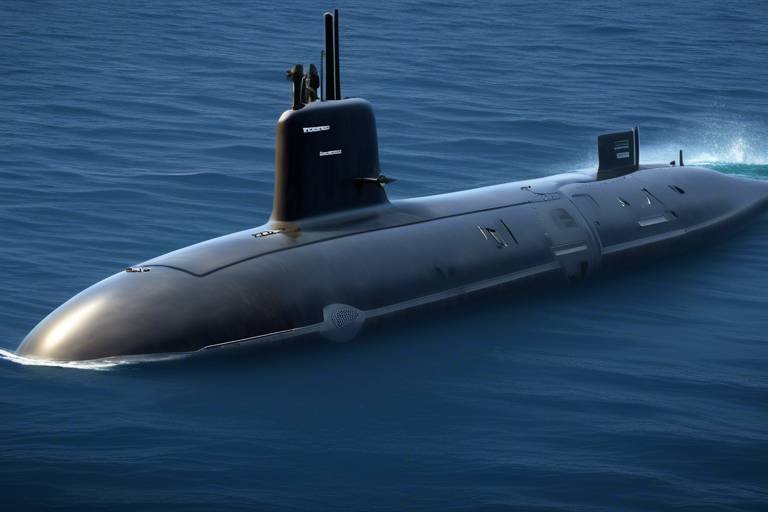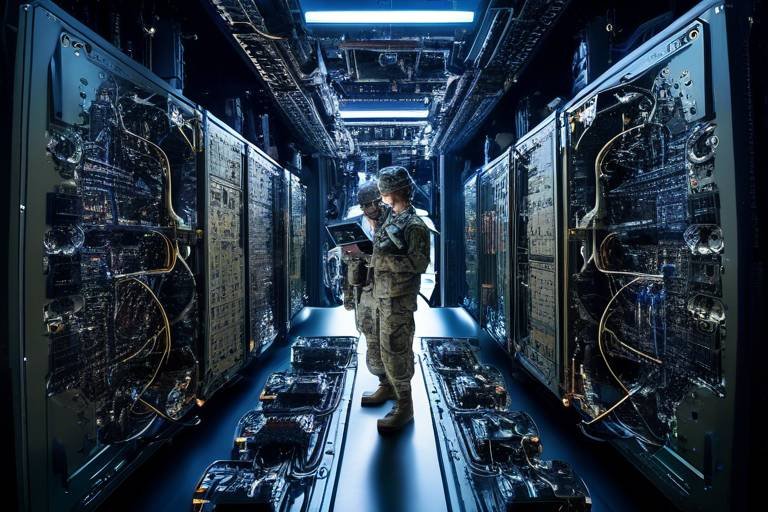Autonomous Aerial Defense Systems - The Future of Air Superiority
In the ever-evolving landscape of military strategy, autonomous aerial defense systems are emerging as a game-changer. These advanced systems are not just about flying drones; they represent a seismic shift in how nations protect their airspace. Imagine a world where machines can make split-second decisions, intercept threats, and adapt to challenges without human intervention. This is not science fiction; it's the reality we are rapidly approaching. As we delve into this topic, we will explore the evolution, technology, and implications of these systems, highlighting their crucial role in modern warfare and the future of air superiority.
At their core, autonomous aerial defense systems are designed to enhance air superiority by leveraging cutting-edge technologies. They utilize a combination of artificial intelligence, machine learning, and advanced sensors to provide real-time responses to aerial threats. This capability marks a significant departure from traditional defense mechanisms, where human operators had to make decisions based on limited information and longer response times. Now, with these systems in place, military forces can swiftly counteract potential threats, ensuring the safety of their airspace with unprecedented efficiency.
The technological advancements driving these systems are nothing short of revolutionary. Recent innovations in artificial intelligence and machine learning have transformed how aerial defense operates. These systems are now capable of functioning autonomously, processing vast amounts of data from multiple sources, and executing complex missions without human oversight. The integration of these technologies allows for enhanced decision-making capabilities, which is crucial in high-stakes environments where every second counts.
With AI and machine learning, aerial defense systems can analyze threats and respond faster than any human operator could. They learn from each encounter, continuously improving their capabilities. This adaptive learning mechanism is akin to how humans learn from experience; however, these systems can process information at a scale and speed that far exceeds human ability. Imagine having a defense system that not only reacts to threats but also evolves based on past encounters—this is the future of aerial defense.
Efficient data processing is critical for the effectiveness of autonomous systems. These systems gather and interpret vast amounts of information from various sensors in real-time. This capability allows them to construct a comprehensive picture of the operational environment, ensuring that they can identify and track potential threats with pinpoint accuracy. The ability to analyze data rapidly and make informed decisions is what sets these systems apart from traditional defense mechanisms.
Adaptive learning mechanisms are integral to the success of autonomous aerial defense systems. These mechanisms enable the systems to improve over time by learning from their past encounters. For instance, if a system encounters a new type of threat, it can analyze the situation, adjust its algorithms, and be better prepared for similar threats in the future. This continuous evolution is essential for maintaining air superiority in an increasingly complex battlefield.
Moreover, the advancements in drone technology have led to the development of more sophisticated and versatile aerial defense systems. Today's drones are equipped with advanced navigation systems, high-resolution cameras, and various weaponry options, making them capable of executing a wide range of missions autonomously. From surveillance to direct engagement, these drones can operate in hostile environments, providing military forces with a significant tactical advantage.
The strategic advantages of these autonomous aerial defense systems are manifold. They enhance operational efficiency, reduce response times, and allow military forces to operate in hostile environments without risking human lives. This shift not only saves lives but also ensures that military operations can be conducted with greater precision and effectiveness.
One of the most compelling arguments for the adoption of autonomous systems is their cost-effectiveness. By minimizing the need for human personnel and decreasing the expenses associated with traditional manned aircraft, military forces can allocate resources more efficiently. This financial benefit is crucial, especially in an era where defense budgets are often under scrutiny.
Furthermore, autonomous aerial defense systems can cover vast areas and respond to multiple threats simultaneously. This capability significantly expands the operational reach of military forces, allowing them to maintain a robust defense posture across larger geographic areas. The ability to monitor and protect extensive airspace without the limitations of human operators is a game-changer in modern warfare.
However, the deployment of autonomous aerial defense systems is not without its challenges. As we embrace these technologies, we must also confront the ethical implications they bring. Questions about accountability, decision-making in combat, and the potential for unintended consequences arise. It's essential to navigate these complex issues carefully to ensure that the advantages of autonomy do not come at the cost of ethical military conduct.
Determining accountability in autonomous warfare is a complex issue. When machines make decisions that lead to significant consequences, who is responsible? This question becomes even more critical in the context of military engagements, where the stakes are incredibly high. Establishing clear guidelines and frameworks for accountability is vital as we move forward with these technologies.
The use of AI in defense systems prompts ethical discussions regarding the morality of automated decision-making, particularly in life-and-death situations. As machines take on more significant roles in warfare, we must consider the implications of allowing algorithms to make critical decisions that could impact human lives. Striking a balance between leveraging technology and maintaining ethical standards is crucial for the future of military operations.
As we look to the future, it's clear that autonomous aerial defense systems will play a pivotal role in shaping air superiority and military strategy on a global scale. The continuous evolution of technology will only enhance these systems' capabilities, making them an indispensable part of modern warfare. Embracing this future requires not only technological advancements but also a commitment to ethical considerations and accountability.
- What are autonomous aerial defense systems?
They are advanced military systems that utilize artificial intelligence and drones to enhance air superiority and respond to threats without human intervention.
- How do these systems improve military operations?
They enhance operational efficiency, reduce response times, and allow for operations in hostile environments without risking human lives.
- What are the ethical concerns surrounding autonomous systems?
Concerns include accountability for decisions made by machines and the morality of automated decision-making in warfare.

Introduction to Autonomous Aerial Defense
Autonomous aerial defense systems represent a significant shift in military strategy, leveraging cutting-edge technologies to enhance air superiority and provide real-time responses to aerial threats. Imagine a battlefield where drones and automated systems work in perfect harmony, detecting and neutralizing threats before they even become visible to human operators. This is not just a futuristic vision; it’s rapidly becoming a reality. As nations invest heavily in these technologies, the dynamics of warfare are transforming, making it crucial to understand what autonomous aerial defense systems entail.
At the heart of these systems lies the ability to operate independently, utilizing advanced algorithms and sensor technologies to make decisions without human intervention. This capability allows for rapid response times, enabling these systems to engage targets with precision and speed that far exceeds traditional manned aircraft. In an era where the speed of warfare is increasing, having an aerial defense system that can react in the blink of an eye is invaluable.
Furthermore, the integration of autonomous systems into military operations raises numerous questions about strategy and ethics. How do we ensure these systems are used responsibly? What happens when machines make decisions that could lead to loss of life? As we delve deeper into the implications of autonomous aerial defense, it’s essential to recognize both the potential benefits and the serious challenges that accompany this technological evolution.
In summary, autonomous aerial defense systems are not merely a technological advancement; they represent a paradigm shift in how military forces operate. By understanding their capabilities and implications, we can better prepare for a future where air superiority is determined not just by the number of aircraft in the sky, but by the intelligence and autonomy of those that fly them.
Frequently Asked Questions
- What are autonomous aerial defense systems?
These are advanced military technologies that utilize drones and automated systems to detect and neutralize aerial threats without human intervention.
- How do these systems enhance military strategy?
They provide rapid response capabilities, operational efficiency, and the ability to operate in hostile environments without risking human lives.
- What are the ethical concerns surrounding autonomous systems?
Issues of accountability, decision-making in combat, and the morality of automated warfare are significant ethical concerns that need to be addressed.

Technological Innovations in Aerial Defense
In the ever-evolving landscape of military technology, autonomous aerial defense systems have emerged as a game changer. These systems are not just equipped with conventional weapons; they are powered by cutting-edge technologies that redefine how we approach aerial warfare. Recent advancements in artificial intelligence, machine learning, and drone technology have created a new breed of aerial defense mechanisms capable of operating independently, making split-second decisions, and adapting to rapidly changing environments.
One of the most significant breakthroughs has been the integration of AI and machine learning into aerial defense systems. Imagine a system that can analyze incoming threats in a fraction of a second, evaluating multiple data points from various sensors and making decisions faster than any human operator could. This is not science fiction—this is the reality of modern warfare. AI algorithms can sift through vast amounts of data, identifying patterns and anomalies that would be impossible for a human to detect in real-time.
The integration of AI and machine learning allows these systems to enhance their decision-making capabilities. For example, when faced with a potential aerial threat, the system can assess the situation by analyzing factors such as speed, altitude, and trajectory. Through continuous learning, these systems refine their algorithms, becoming more efficient and accurate with each encounter. This capability is akin to a seasoned chess player who learns from every match, continually improving their strategy.
Efficient data processing is the backbone of autonomous aerial defense systems. These systems are designed to gather and interpret data from a myriad of sources, including radar, infrared sensors, and satellite imagery. The ability to process this information in real-time is crucial for making informed decisions. For instance, a drone equipped with advanced sensors can detect an incoming missile and calculate the best course of action within milliseconds, ensuring a timely response to mitigate the threat.
Adaptive learning mechanisms are another cornerstone of these technological innovations. They allow aerial defense systems to evolve and improve their performance over time. By analyzing past encounters and outcomes, these systems can adjust their tactics and strategies to counter new threats. This is similar to how a skilled athlete reviews game footage to understand their weaknesses and enhance their performance in future competitions.
Moreover, advancements in drone technology have led to the creation of more sophisticated and versatile aerial defense systems. Today's drones are not just flying cameras; they are equipped with advanced navigation systems, enhanced payload capabilities, and superior maneuverability. This versatility allows them to execute complex missions autonomously, whether it’s surveillance, reconnaissance, or direct engagement with hostile targets.
As we look to the future, it's clear that the integration of these technological innovations will continue to shape the battlefield. The ability to operate autonomously, coupled with real-time data processing and adaptive learning, positions autonomous aerial defense systems as the backbone of modern military strategy.
- What are autonomous aerial defense systems?
These are advanced military systems designed to operate without human intervention, using AI and machine learning to respond to aerial threats. - How do these systems make decisions?
They analyze vast amounts of data from various sensors in real-time, enabling them to make quick and informed decisions. - What are the advantages of using drones in aerial defense?
Drones can cover large areas, respond to multiple threats simultaneously, and reduce the risk to human lives. - What ethical concerns are associated with autonomous aerial defense systems?
Concerns include accountability for decisions made by machines and the morality of automated warfare.
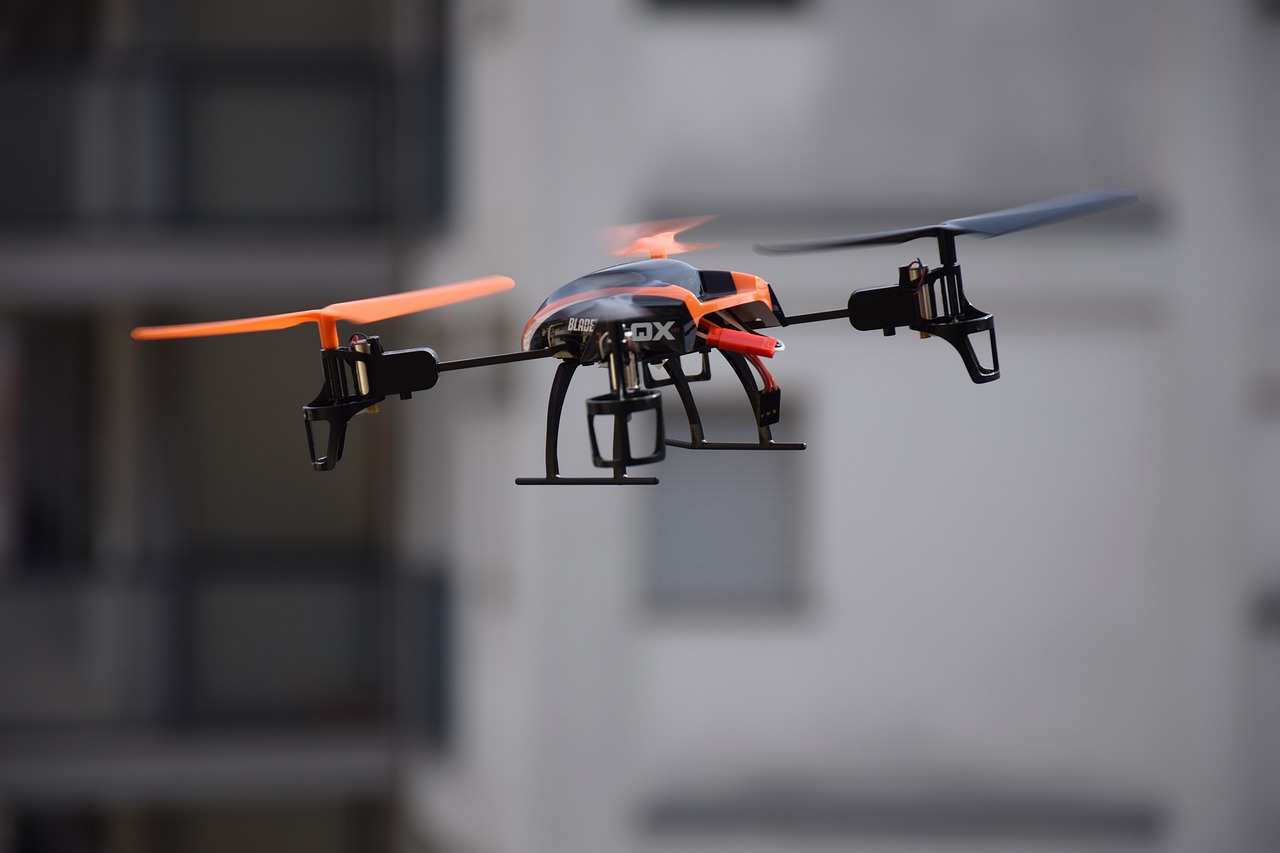
AI and Machine Learning Integration
Imagine a scenario where a military drone can identify and neutralize threats faster than a human pilot can react. This is no longer science fiction; it’s the reality brought forth by the integration of artificial intelligence (AI) and machine learning into autonomous aerial defense systems. These technologies enhance the operational capabilities of these systems, allowing them to process information and make decisions in real-time, significantly improving air superiority.
At the heart of this integration lies the ability of AI to analyze vast amounts of data quickly. For instance, a drone equipped with advanced sensors can gather information from multiple sources—radar, infrared, and visual inputs. The machine learning algorithms then sift through this data to identify potential threats, classify them, and determine the best course of action. This capability is akin to having a super-intelligent assistant who can sift through mountains of information in seconds, providing military operators with actionable insights almost instantaneously.
Moreover, the adaptive nature of these systems allows them to learn from their experiences. Each encounter with a threat contributes to the system's knowledge base, refining its algorithms and improving its response strategies. This is not just about reacting to threats; it’s about evolving with them. For example, if a drone encounters a new type of missile, it can analyze the situation, learn from it, and adjust its tactics for future engagements. This continuous learning process is critical in an ever-changing battlefield where new technologies and tactics emerge constantly.
Additionally, the integration of AI and machine learning can drastically reduce the cognitive load on human operators. In high-pressure situations, decisions need to be made swiftly. By leveraging AI, the system can provide recommendations based on real-time data, allowing human operators to focus on strategic oversight rather than getting bogged down in the minutiae of data analysis. This synergy between human intuition and machine intelligence creates a powerful defense mechanism that can adapt and respond to threats with unprecedented speed and accuracy.
However, the integration of AI and machine learning into aerial defense systems is not without its challenges. As these systems become more autonomous, questions arise regarding the ethical implications of their decision-making processes. Who is responsible if a machine makes a mistake? How do we ensure that these systems operate within the bounds of international law? These are critical questions that must be addressed as we move towards a future where autonomous systems play a central role in military operations.
In conclusion, the integration of AI and machine learning into autonomous aerial defense systems represents a groundbreaking shift in military strategy. By enhancing decision-making capabilities and enabling systems to learn and adapt, these technologies are redefining what it means to achieve air superiority. As we continue to explore the potential of these innovations, it is essential to remain vigilant about the ethical implications they bring, ensuring that we harness their power responsibly.
- What is AI integration in aerial defense systems? AI integration involves using artificial intelligence to enhance the capabilities of aerial defense systems, allowing them to analyze data and make decisions autonomously.
- How does machine learning improve aerial defense? Machine learning enables aerial defense systems to learn from past encounters, improving their performance and response to new threats over time.
- What are the ethical concerns of autonomous aerial defense? Ethical concerns include accountability for decisions made by machines and the morality of automated decision-making in life-and-death situations.
- Can these systems operate without human intervention? While autonomous aerial defense systems can operate independently, human oversight is crucial for strategic decision-making and ethical considerations.
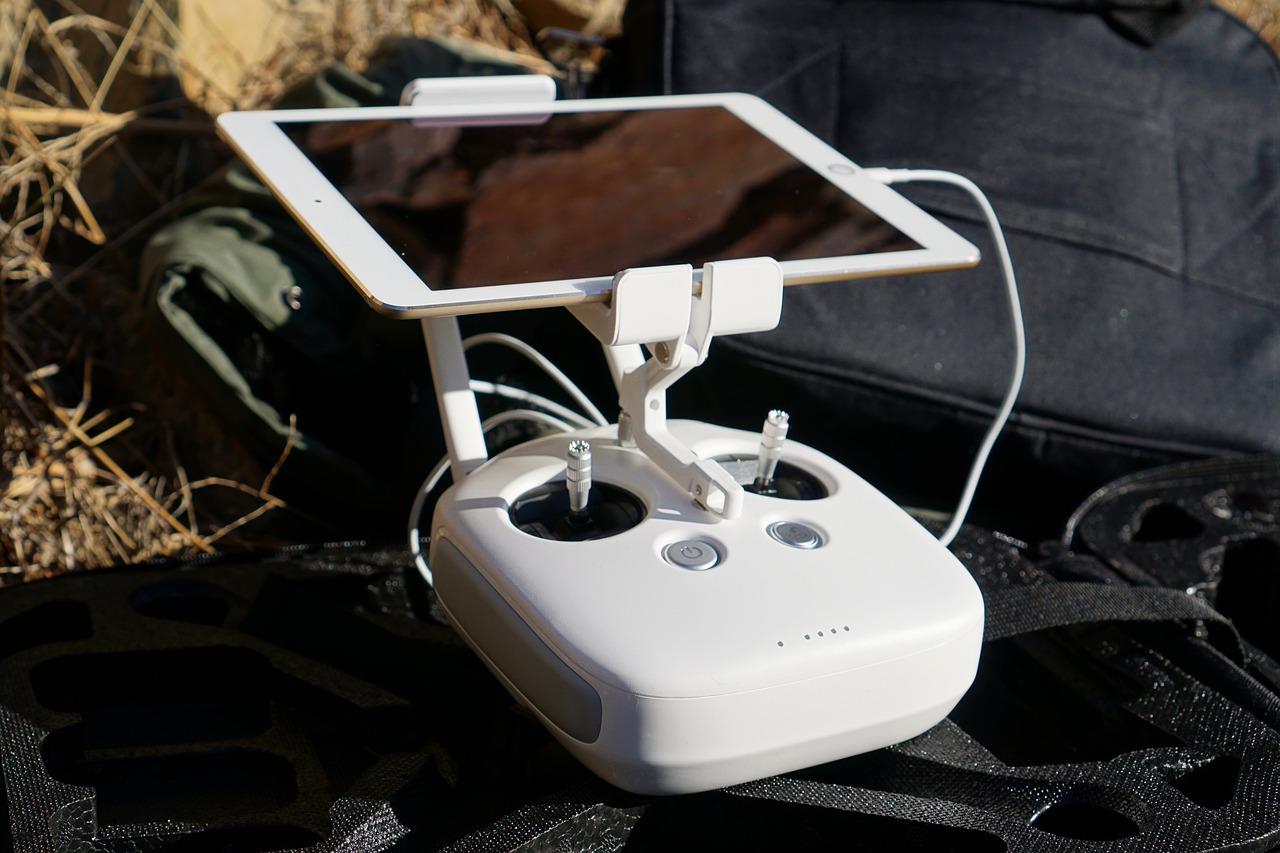
Data Processing and Analysis
In the realm of autonomous aerial defense systems, serve as the backbone of operational efficiency. These systems are designed to handle an overwhelming amount of data from various sources, including sensors, cameras, and radar systems, all while maintaining real-time responsiveness. Imagine trying to find a needle in a haystack—now, imagine that haystack is constantly changing as new threats emerge. This is the challenge that autonomous systems face daily.
To tackle this, advanced algorithms are employed to sift through vast datasets, identifying patterns and anomalies that may indicate potential threats. Machine learning plays a crucial role here, as it allows these systems to not only analyze data but also to learn from it. For instance, if an aerial defense system encounters a new type of drone, it can analyze the data from that encounter, adapt its responses, and improve its effectiveness in future scenarios. This is akin to a student studying for an exam—each time they review their notes, they become better equipped to handle similar questions in the future.
Additionally, the integration of real-time data processing ensures that decisions are made swiftly. When faced with multiple threats, an autonomous system must prioritize which target to engage first. This requires not just speed but also accuracy, as the consequences of a miscalculation can be dire. For example, a system might analyze the trajectory of incoming projectiles and calculate their impact points, all while considering the safety of friendly forces. The ability to process this information in milliseconds can mean the difference between success and failure in a military operation.
Furthermore, the data processing capabilities of these systems are enhanced by cloud computing technologies, which allow for the storage and analysis of massive datasets beyond the limitations of onboard systems. By leveraging cloud resources, autonomous aerial defense systems can access a broader range of information and utilize more powerful computational resources. This collaborative approach not only boosts performance but also facilitates the sharing of intelligence across different military units, creating a more cohesive and informed defense strategy.
In summary, the synergy of in autonomous aerial defense systems is a game-changer for modern warfare. It empowers these systems to operate with a level of precision and adaptability that was previously unimaginable. As we look to the future, the continued evolution of these technologies will undoubtedly redefine the landscape of air superiority.
- What are autonomous aerial defense systems? Autonomous aerial defense systems are advanced military technologies that use artificial intelligence and machine learning to detect, analyze, and respond to aerial threats without human intervention.
- How do these systems process data? They utilize sophisticated algorithms and real-time data analysis to interpret information from various sensors, enabling them to make quick decisions in dynamic environments.
- What are the benefits of using AI in aerial defense? The integration of AI enhances decision-making speed, improves threat detection accuracy, and allows for adaptive learning, making these systems more effective over time.
- Are there ethical concerns associated with autonomous aerial defense systems? Yes, ethical concerns include accountability for decisions made by machines, potential unintended consequences, and the morality of automated warfare.

Adaptive Learning Mechanisms
Adaptive learning mechanisms are at the forefront of transforming how autonomous aerial defense systems operate. Imagine a system that not only reacts to threats but learns from every encounter, evolving its strategies and tactics over time. This capability is akin to a seasoned fighter pilot who gains invaluable experience with each mission, adapting to new challenges and refining their skills. In the realm of aerial defense, this means that drones and other autonomous systems can improve their effectiveness against a myriad of threats, from enemy aircraft to incoming missiles.
One of the most exciting aspects of these mechanisms is their ability to utilize machine learning algorithms. These algorithms analyze vast amounts of data collected during operations, identifying patterns and trends that human operators might overlook. For instance, if an aerial defense system encounters a new type of drone or missile, it can catalog this information and adjust its response protocols accordingly. Over time, this leads to a more robust and capable defense network, ready to tackle evolving threats.
Moreover, the integration of adaptive learning allows for real-time adjustments based on environmental changes. For example, if a defense system is deployed in an unfamiliar territory, it can quickly gather data about the local airspace, weather conditions, and potential threats. By processing this information on-the-fly, the system can make informed decisions that enhance its operational effectiveness. This is particularly crucial in dynamic combat scenarios where every second counts.
To illustrate the impact of adaptive learning, consider the following table showcasing potential improvements in response time and threat identification accuracy:
| Parameter | Before Adaptive Learning | After Adaptive Learning |
|---|---|---|
| Response Time | 5 seconds | 2 seconds |
| Threat Identification Accuracy | 75% | 90% |
As we can see, the implementation of adaptive learning mechanisms can significantly enhance the performance of aerial defense systems. However, it’s not just about speed and accuracy; it’s also about the ability to anticipate and mitigate potential threats before they escalate. This proactive approach is crucial in modern warfare, where the landscape is constantly shifting and the stakes are higher than ever.
In conclusion, adaptive learning mechanisms are revolutionizing the way autonomous aerial defense systems function. By enabling these systems to learn and adapt, we are not only improving their immediate effectiveness but also ensuring they remain relevant in a rapidly changing battlefield. The future of aerial defense is undoubtedly bright, with adaptive learning at the helm, steering us toward a new era of military strategy and air superiority.
- What are adaptive learning mechanisms?
Adaptive learning mechanisms refer to technologies that enable systems to learn from experiences and improve their performance over time.
- How do these mechanisms enhance aerial defense systems?
They enhance aerial defense systems by allowing them to analyze past encounters, adjust strategies, and improve response times and accuracy against threats.
- What role does machine learning play in adaptive learning?
Machine learning algorithms analyze data collected during operations to identify patterns, enabling systems to adapt and refine their responses to emerging threats.
- Can adaptive learning mechanisms operate in real-time?
Yes, these mechanisms can gather and process data in real-time, allowing for immediate adjustments based on environmental changes and new threats.

Drone Technology Advancements
The landscape of military operations has undergone a dramatic transformation, thanks in large part to the advancements in drone technology. These flying marvels have evolved from simple remote-controlled devices into complex, autonomous systems capable of performing a myriad of tasks. Imagine a world where drones can not only survey vast territories but also engage threats with pinpoint accuracy—all without human intervention. This is the reality we are stepping into, and it’s nothing short of revolutionary.
One of the most exciting aspects of drone technology is their autonomy. Modern drones are equipped with sophisticated algorithms that allow them to make real-time decisions based on their surroundings. This means they can navigate through challenging environments, avoid obstacles, and even coordinate with other drones to execute complex missions. For instance, a fleet of drones can work together to create a dynamic surveillance network, relaying critical information back to command centers without needing a human operator to direct each move.
Furthermore, advancements in sensor technology have significantly enhanced the capabilities of drones. Today’s drones can be outfitted with an array of sensors, including thermal imaging, radar, and even chemical detection systems. This multi-sensory approach not only improves their situational awareness but also allows them to operate effectively in various conditions, whether it’s a bright sunny day or a foggy night. The ability to gather and process data from multiple sources in real-time is a game changer for military operations.
Another key development is the improved battery technology that extends the flight duration of drones. Earlier models were often limited by their power supply, restricting their operational range. However, with innovations in battery efficiency and energy management, drones can now remain airborne for hours, covering more ground and providing continuous surveillance or support. This capability is particularly advantageous in military scenarios where prolonged presence can mean the difference between success and failure.
Moreover, the integration of machine learning into drone systems is paving the way for even greater advancements. Drones equipped with machine learning algorithms can analyze data patterns and learn from their experiences. For example, if a drone encounters a new type of threat, it can adapt its response based on previous encounters, effectively evolving its strategies over time. This adaptive learning capability ensures that drones remain effective against emerging threats, making them invaluable assets in modern warfare.
As we look to the future, the potential for drone technology is virtually limitless. With ongoing research and development, we can expect to see even more sophisticated drones that can operate in swarms, share intelligence seamlessly, and execute missions with unparalleled efficiency. The implications for air superiority are profound, as these advancements not only enhance military effectiveness but also redefine the very nature of warfare.
- What are the primary advantages of using drones in military operations?
Drones provide enhanced surveillance, increased operational reach, and the ability to conduct missions without risking human lives. - How do drones make decisions autonomously?
Drones utilize advanced algorithms and machine learning to analyze their environment and make real-time decisions based on the data they gather. - What role do sensors play in drone technology?
Sensors enhance a drone's situational awareness, enabling it to operate effectively in varying conditions and gather critical data for mission success. - Can drones adapt to new threats?
Yes, drones equipped with machine learning can learn from their experiences and adapt their responses to new threats over time.

Strategic Advantages of Autonomous Systems
Autonomous aerial defense systems are not just a passing trend; they represent a revolutionary leap in military capabilities. One of the most compelling advantages is their enhanced operational efficiency. Imagine a scenario where drones can monitor vast swathes of airspace, identifying and neutralizing threats without the need for constant human oversight. This capability allows military forces to maintain a vigilant watch over their territories while reallocating human resources to other critical operations.
Moreover, these systems are designed to reduce response times significantly. In a world where every second counts, the ability to react almost instantaneously to aerial threats can mean the difference between success and failure in combat. Autonomous systems can process data and execute decisions at speeds far beyond human capability. This rapid response is crucial when dealing with fast-moving threats such as enemy aircraft or incoming missiles.
Another strategic advantage is the ability to operate in hostile environments without risking human lives. Traditional military operations often require putting pilots in dangerous situations, exposing them to enemy fire and other risks. However, with autonomous systems, military forces can engage in operations that would otherwise be too risky for human personnel. This not only preserves lives but also allows for a more aggressive posture in defense strategies.
Furthermore, the cost-effectiveness of these systems cannot be overlooked. Operational costs can be drastically reduced as the need for extensive human crews diminishes. This shift allows defense budgets to be reallocated to other areas, such as research and development or personnel training. In a time when military budgets are scrutinized more than ever, the financial savings associated with autonomous systems represent a significant advantage.
To illustrate the impact of these advantages, consider the following table that outlines key benefits:
| Advantage | Description |
|---|---|
| Operational Efficiency | Maximizes resource allocation and monitoring capabilities. |
| Reduced Response Times | Enables immediate reaction to threats, enhancing tactical advantages. |
| Risk Mitigation | Operates in dangerous environments without endangering human lives. |
| Cost-Effectiveness | Reduces operational costs by minimizing the need for human personnel. |
In summary, the strategic advantages of autonomous aerial defense systems are profound. They not only enhance military capabilities but also reshape how we think about air superiority in modern warfare. As these technologies continue to evolve, they will undoubtedly play a critical role in future military strategies.
- What are autonomous aerial defense systems?
They are advanced military technologies that use artificial intelligence and drones to monitor and respond to aerial threats without human intervention.
- How do these systems enhance operational efficiency?
They allow for real-time monitoring and threat identification, enabling military forces to allocate human resources more effectively.
- What is the impact of reduced response times?
Faster response times can significantly improve tactical advantages in combat scenarios, allowing for immediate action against threats.
- Are there ethical concerns regarding autonomous systems?
Yes, there are ongoing discussions about accountability and the morality of automated decision-making in warfare.

Cost-Effectiveness in Military Operations
When we think about modern warfare, the financial implications are just as critical as the tactical ones. Autonomous aerial defense systems (AADS) are not only changing the game in terms of strategy but also in terms of cost-effectiveness. Imagine a scenario where military operations can be conducted with fewer resources while achieving superior results. This is precisely what AADS bring to the table. By utilizing these advanced systems, military forces can significantly cut down on operational costs while enhancing their overall effectiveness.
One of the main advantages of AADS is their ability to operate without the need for human pilots. This not only reduces the costs associated with training and maintaining personnel but also minimizes the risks associated with human life in combat situations. For instance, consider the expenses related to a traditional manned aircraft:
| Expense Category | Manned Aircraft | Autonomous Aerial Defense Systems |
|---|---|---|
| Training Costs | High | Minimal |
| Maintenance | High | Lower |
| Operational Costs | High | Reduced |
This table illustrates how AADS can dramatically lower the expenses that come with traditional military operations. With less need for extensive training, fewer maintenance requirements, and overall reduced operational costs, the savings can be redirected towards other vital areas, such as research and development or enhancing ground forces.
Moreover, the flexibility of autonomous systems allows for quicker deployment and adaptability in the field. They can be deployed in various environments and situations without the lengthy preparations associated with manned missions. This agility not only saves time but also allows for a rapid response to emerging threats, further justifying their cost-effectiveness.
Another noteworthy factor is the ability of AADS to operate in high-risk environments where human pilots might be at significant risk. By utilizing drones and other autonomous systems, military forces can engage in missions that would otherwise be too dangerous, thereby preserving human life and resources. In essence, AADS serve as a force multiplier, allowing for more operations to be conducted with fewer assets.
In conclusion, the cost-effectiveness of autonomous aerial defense systems is evident in various aspects of military operations. By reducing training and operational costs, increasing flexibility, and preserving human resources, these systems not only enhance military capabilities but also provide a more sustainable approach to modern warfare. As we look to the future, it’s clear that the integration of AADS will continue to reshape the financial landscape of military operations.
- What are autonomous aerial defense systems?
These are advanced military systems that operate without human pilots, utilizing artificial intelligence and other technologies to engage aerial threats.
- How do AADS reduce operational costs?
By minimizing the need for human personnel, lowering training expenses, and decreasing maintenance costs associated with traditional aircraft.
- Can AADS operate in hostile environments?
Yes, they are designed to function in high-risk situations, reducing the danger to human life during military operations.

Increased Operational Reach
The advent of autonomous aerial defense systems has dramatically transformed military operations, particularly in terms of operational reach. Imagine a vast battlefield where traditional aircraft struggle to cover every inch, often limited by human factors like fatigue and reaction time. Autonomous systems break through these barriers, offering an unprecedented ability to monitor and protect extensive areas simultaneously. This capability is akin to having a fleet of vigilant sentinels, each equipped with the intelligence to act swiftly against emerging threats.
One of the key benefits of these systems is their ability to operate in hostile environments where human pilots might be at risk. For instance, in scenarios involving high-stakes conflicts or environments with heavy enemy defenses, deploying autonomous drones allows military forces to maintain a presence without endangering lives. The drones can be programmed to patrol vast territories, gather intelligence, and engage potential threats, all while communicating with one another to form a cohesive defense network.
Moreover, the integration of advanced sensors and communication technologies enhances the operational reach of these systems. Equipped with high-resolution cameras, infrared sensors, and radar, autonomous aerial defense systems can detect and track multiple targets over large distances. This capability not only improves situational awareness but also enables quicker response times to threats that may arise from different directions. For instance, a single autonomous drone can cover a radius of several hundred miles, significantly amplifying the area of operation compared to traditional manned aircraft.
To illustrate the impact of increased operational reach, consider the following table that compares traditional manned aircraft with autonomous aerial defense systems:
| Feature | Traditional Manned Aircraft | Autonomous Aerial Defense Systems |
|---|---|---|
| Operational Range | Limited by pilot endurance | Extended range with no fatigue |
| Response Time | Subject to human reaction time | Instantaneous decision-making |
| Risk to Personnel | High | Minimal |
| Cost of Operation | Higher due to crew and maintenance | Lower with reduced crew requirements |
As military strategies evolve, the ability to deploy multiple autonomous aerial defense systems across various theaters of operation will become a game changer. The synergy created by these systems can facilitate a more robust defense posture, allowing military forces to deter threats before they can escalate. This increased operational reach not only enhances the effectiveness of military missions but also contributes to a more secure environment for both military personnel and civilians alike.
- What are autonomous aerial defense systems? Autonomous aerial defense systems are advanced military technologies that operate without human intervention, utilizing artificial intelligence to identify and respond to threats.
- How do these systems improve operational reach? They can cover larger areas, respond to multiple threats quickly, and operate in environments where human pilots may be at risk.
- What are the ethical concerns surrounding these systems? Ethical concerns include accountability for decisions made by machines and the implications of automated warfare.
- Can autonomous systems replace traditional aircraft entirely? While they significantly enhance capabilities, a combination of both may be necessary for optimal military effectiveness.
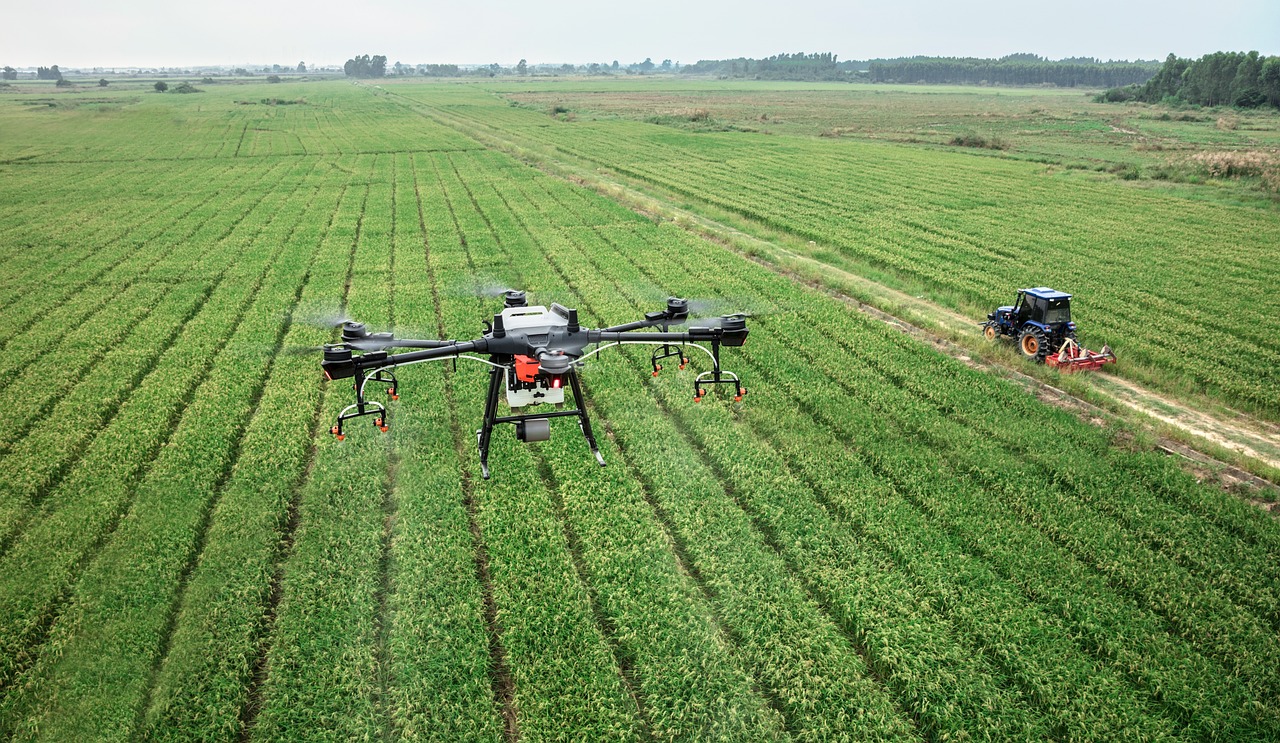
Challenges and Ethical Considerations
As we dive deeper into the world of autonomous aerial defense systems, it's essential to acknowledge that with great power comes great responsibility. While these systems promise to revolutionize military strategy and enhance air superiority, they also present a myriad of challenges and ethical dilemmas that cannot be ignored. One of the most pressing concerns is the issue of accountability. When machines make decisions that could lead to life or death situations, who is responsible for those choices? Is it the programmer, the military command, or the machine itself? These questions linger ominously as we navigate the complexities of autonomous warfare.
Moreover, the ethical implications of employing artificial intelligence in defense systems raise significant moral concerns. Automated decision-making in combat scenarios can lead to unintended consequences, such as collateral damage or misidentification of targets. Imagine a scenario where an autonomous drone misinterprets a civilian gathering as a military threat—this could result in catastrophic outcomes. The absence of human judgment in these critical moments poses a risk that society must grapple with.
Another challenge is the potential for bias in the algorithms that drive these systems. If the data used to train these AI models contains inherent biases, the outcomes could be skewed, leading to unfair targeting or discrimination. This raises the question: how do we ensure that autonomous systems are fair and just? The answer is not simple and requires ongoing scrutiny and refinement of the algorithms involved.
To further illustrate these challenges, consider the following table that outlines key ethical concerns associated with autonomous aerial defense systems:
| Ethical Concern | Description |
|---|---|
| Accountability | Determining who is responsible for decisions made by autonomous systems. |
| Decision-Making | The morality of machines making life-and-death decisions in combat. |
| Bias in Algorithms | The risk of unfair targeting due to biased training data. |
| Unintended Consequences | Potential for collateral damage and misidentification of targets. |
As we advance into this new era of warfare, it is crucial to engage in open discussions about these challenges. Military leaders, ethicists, technologists, and society at large must collaborate to establish robust frameworks that govern the use of autonomous systems in defense. This dialogue will be vital in ensuring that we harness the power of technology responsibly and ethically.
- What are autonomous aerial defense systems?
These are advanced military technologies that use AI and drones to identify and respond to aerial threats without direct human intervention. - What ethical concerns are associated with autonomous warfare?
Key concerns include accountability for decisions made by machines, potential biases in AI algorithms, and the risk of unintended consequences. - How can we ensure fairness in autonomous systems?
Ongoing scrutiny and refinement of AI algorithms, alongside diverse data sets, are essential to mitigating bias and ensuring equitable outcomes. - What role do humans play in autonomous aerial defense systems?
While these systems operate autonomously, human oversight remains crucial for accountability and ethical decision-making.

Accountability in Autonomous Warfare
The rise of autonomous aerial defense systems brings with it a myriad of questions surrounding accountability in warfare. When machines make life-and-death decisions, who is held responsible for the outcomes? This dilemma becomes increasingly complex when considering that these systems operate based on algorithms and data rather than human judgment. In traditional warfare, accountability typically rests with human commanders; however, the introduction of AI-driven systems challenges this norm.
One of the primary concerns is the chain of command. In a situation where an autonomous drone mistakenly engages a civilian target, who can be held accountable? Is it the programmer who wrote the code, the military official who deployed the system, or the machine itself? The ambiguity in responsibility raises ethical questions that military strategists must grapple with. The potential for unintended consequences is significant, and the ramifications of these decisions can be profound.
Furthermore, the concept of moral agency comes into play. Can a machine be considered a moral agent, capable of understanding the implications of its actions? Most would argue that machines lack the ability to comprehend morality, which places the onus back on humans. However, as these systems become more sophisticated, the lines blur. For instance, if an autonomous system is programmed to engage threats based on specific criteria, what happens if those criteria are flawed or misinterpreted? The consequences could be catastrophic.
To address these challenges, military organizations and policymakers are beginning to explore frameworks for accountability in autonomous warfare. Some potential approaches include:
- Establishing Clear Guidelines: Developing comprehensive guidelines that outline the responsibilities of all parties involved in the deployment and operation of autonomous systems.
- Implementing Oversight Mechanisms: Creating oversight bodies to monitor the use of autonomous systems in combat, ensuring compliance with ethical standards and international law.
- Enhancing Transparency: Promoting transparency in the algorithms used by these systems, allowing for better understanding and scrutiny of decision-making processes.
In conclusion, accountability in autonomous warfare is a complex issue that requires careful consideration. As we advance into an era where machines play an increasingly significant role in military operations, it is imperative to establish clear frameworks that ensure responsible use of technology. Failure to do so could lead to dire consequences, not just for combatants but for innocent civilians caught in the crossfire.
- What are autonomous aerial defense systems? Autonomous aerial defense systems are advanced military technologies that utilize artificial intelligence and machine learning to operate independently in addressing aerial threats.
- Who is responsible for decisions made by autonomous systems? The question of accountability is complex and can involve multiple parties, including programmers, military officials, and the systems themselves.
- Can machines understand morality? Currently, machines lack the ability to comprehend morality, which raises ethical concerns about their use in warfare.
- What measures are being taken to ensure accountability? Measures include establishing guidelines, implementing oversight mechanisms, and enhancing transparency in decision-making processes.

Ethical Implications of AI in Defense
The integration of artificial intelligence (AI) into defense systems is not just a technological revolution; it is also a profound ethical dilemma. As we stand on the brink of an era where machines could potentially make life-and-death decisions, it raises a multitude of questions that society must grapple with. The prospect of autonomous aerial defense systems operating without human intervention brings with it a host of ethical implications that cannot be ignored.
One of the primary concerns is the morality of automated decision-making. Can we trust machines to make the right choices in high-stakes situations? Unlike a human operator who can apply empathy and moral reasoning, an AI system relies on algorithms and data, which may not always capture the nuances of human life. For instance, in a combat scenario, an autonomous drone might identify a target based on its programming but fail to account for civilians in the vicinity. This lack of human judgment could lead to catastrophic consequences.
Moreover, the question of accountability looms large. If an autonomous system makes a mistake, who is responsible? Is it the programmer, the military command, or the machine itself? This ambiguity complicates military engagements and raises significant legal and ethical challenges. As technology evolves, we need to establish clear guidelines and frameworks that define responsibility in these situations.
Another critical aspect is the potential for bias in AI algorithms. AI systems learn from historical data, which can inadvertently contain biases reflecting societal prejudices. If these biases are not addressed, they could lead to discriminatory practices in military operations, disproportionately affecting certain groups. This is particularly concerning when considering the global implications of deploying such technologies.
Furthermore, as we develop these systems, we must consider the psychological impact on soldiers and society at large. The idea of machines making life-and-death decisions could desensitize military personnel and the public to the realities of warfare. It may create a disconnect between the act of war and its consequences, leading to a troubling normalization of violence.
In light of these ethical challenges, it is crucial for policymakers, technologists, and ethicists to engage in ongoing dialogue about the implications of AI in defense. This includes establishing robust ethical standards and regulations that govern the development and deployment of autonomous systems. Only through comprehensive discussions can we hope to navigate the complex landscape of AI in military applications responsibly.
In summary, the ethical implications of AI in defense are vast and complex. As we advance towards a future where autonomous systems play a pivotal role in warfare, we must remain vigilant and proactive in addressing these concerns. The stakes are high, and the decisions we make today will shape the moral landscape of military engagements for generations to come.
- What are the main ethical concerns regarding AI in defense? The main concerns include automated decision-making, accountability, bias in algorithms, and the psychological impact on military personnel and society.
- Who is responsible if an autonomous system makes a mistake? Accountability in such cases is complex and can involve programmers, military command, or the machine itself.
- How can we ensure AI systems are free from bias? Addressing bias requires careful examination of the data used to train AI systems and implementing diverse datasets to minimize discriminatory outcomes.
- What role do policymakers play in regulating AI in defense? Policymakers are crucial in establishing ethical standards and regulations that govern the development and use of autonomous systems in military applications.

The Future of Air Superiority
The landscape of military strategy is evolving at an unprecedented pace, and at the forefront of this transformation are autonomous aerial defense systems. As nations invest heavily in cutting-edge technologies, the future of air superiority promises to be dominated by these intelligent machines. Imagine a battlefield where drones equipped with advanced AI not only detect threats but also make real-time decisions to neutralize them—this is not science fiction; it's the imminent reality of modern warfare.
With the integration of machine learning and artificial intelligence, these systems are becoming more sophisticated, capable of adapting to new challenges and learning from previous encounters. The future will see aerial defense systems that can operate independently, coordinating with other military assets to create a comprehensive defense network. This level of integration will enhance situational awareness, allowing for a more proactive approach to threats.
Moreover, the strategic implications of these advancements cannot be overstated. As we move forward, the ability of autonomous systems to cover vast areas and respond to multiple threats simultaneously will redefine what it means to achieve air superiority. In fact, the operational reach of military forces will expand dramatically, allowing for rapid deployments and responses that were previously unthinkable.
However, it’s essential to recognize that with great power comes great responsibility. As we embrace these technologies, we must also confront the ethical dilemmas they pose. Questions surrounding accountability in autonomous warfare and the morality of AI-driven decision-making will require careful consideration and robust frameworks to ensure responsible use. The balance between leveraging technological advancements and maintaining ethical standards will be a critical challenge for military leaders and policymakers alike.
In summary, the future of air superiority is not just about having the most advanced technology; it's about how we integrate these systems into our military strategies. The shift towards autonomous aerial defense systems heralds a new era where speed, efficiency, and intelligence will dictate the outcomes of aerial engagements. As we look ahead, it’s clear that the sky may soon belong to machines, but it will be our duty to ensure they operate within the bounds of human ethics and accountability.
- What are autonomous aerial defense systems?
These are advanced military technologies that operate independently to detect and respond to aerial threats using artificial intelligence and machine learning. - How do these systems enhance air superiority?
They provide real-time responses to threats, cover larger operational areas, and reduce response times, thereby allowing military forces to maintain control of the skies. - What ethical concerns are associated with autonomous systems?
Key concerns include accountability for decisions made by machines, the morality of automated warfare, and the potential for unintended consequences in combat scenarios. - Will autonomous systems replace human pilots?
While they may complement human roles, the complete replacement of human pilots is unlikely due to the complex decision-making required in warfare.
Frequently Asked Questions
- What are autonomous aerial defense systems?
Autonomous aerial defense systems are advanced military technologies designed to enhance air superiority. They utilize artificial intelligence, machine learning, and drone technology to operate independently, making real-time decisions to counter aerial threats without direct human intervention.
- How do AI and machine learning improve aerial defense?
AI and machine learning enhance aerial defense systems by enabling them to analyze vast amounts of data quickly and accurately. This integration allows these systems to make informed decisions faster than human operators, adapting to new threats and evolving tactics in real-time.
- What are the strategic advantages of using autonomous systems in warfare?
Autonomous systems offer several strategic advantages, including increased operational efficiency, reduced response times, and the ability to operate in hostile environments without risking human lives. They can cover larger areas and respond to multiple threats simultaneously, enhancing military effectiveness.
- Are there ethical concerns regarding autonomous aerial defense systems?
Yes, the deployment of autonomous systems raises significant ethical questions. Issues such as accountability for decisions made by machines and the morality of automated decision-making in life-and-death situations are critical discussions in military ethics today.
- How do autonomous aerial defense systems impact military costs?
These systems can significantly reduce military operational costs by decreasing the reliance on human personnel and minimizing the expenses associated with traditional manned aircraft. This cost-effectiveness allows for better allocation of resources within military budgets.
- What is the future of air superiority with autonomous systems?
The future of air superiority is likely to be heavily influenced by autonomous aerial defense systems. As technology continues to advance, these systems will play a crucial role in shaping military strategies and operations on a global scale, potentially redefining how air warfare is conducted.




